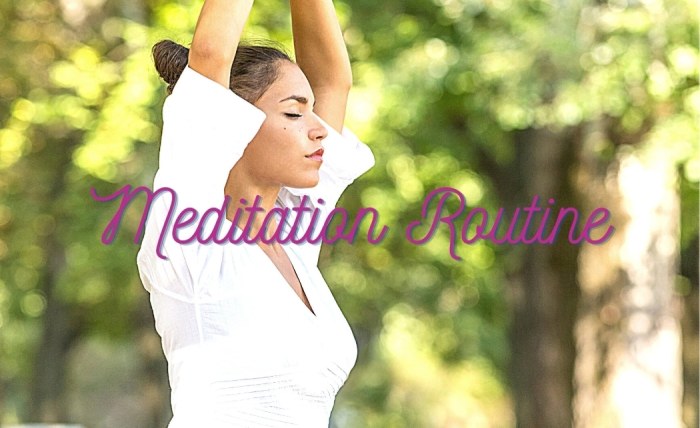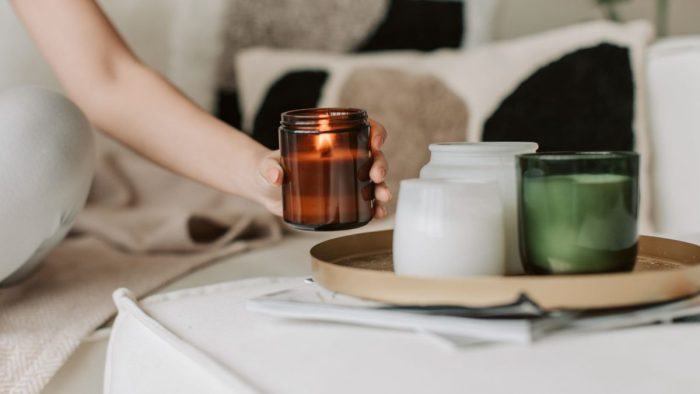6 Ways to Create a Meditation Routine introduces the key steps to establish a regular practice that can significantly improve overall well-being. From setting clear goals to tracking progress, this guide offers valuable insights for beginners and seasoned practitioners alike.
Creating a meditation routine can be a transformative experience, leading to increased mindfulness, reduced stress, and improved mental clarity. Let’s delve into the essential aspects of building a consistent meditation practice.
Introduction to Meditation Routine

A meditation routine refers to the practice of setting aside dedicated time each day to engage in meditation techniques. This consistent practice helps individuals cultivate mindfulness, reduce stress, and improve overall mental well-being.
Establishing a regular meditation practice offers a wide range of benefits for both the mind and body. It can help individuals develop a greater sense of self-awareness, enhance focus and concentration, promote emotional stability, and reduce symptoms of anxiety and depression. Moreover, regular meditation has been linked to improved sleep quality, reduced blood pressure, and strengthened immune function.
Enhancing Overall Well-being
Creating a meditation routine can significantly enhance overall well-being by providing a sense of structure and stability in daily life. By incorporating meditation into daily habits, individuals can experience increased mental clarity, emotional resilience, and a greater sense of inner peace. Consistent practice also helps in developing a deeper connection with oneself and fostering a positive outlook on life.
Setting Clear Meditation Goals: 6 Ways To Create A Meditation Routine

Setting clear meditation goals is essential for individuals looking to establish a consistent and effective meditation routine. By defining specific objectives, practitioners can track their progress, stay focused, and maintain motivation throughout their practice.
Importance of Setting Specific Meditation Goals
- Enhances Focus: Setting clear goals helps individuals concentrate on their meditation practice, reducing distractions and improving mindfulness.
- Measurable Progress: Specific goals allow practitioners to measure their development over time, providing a sense of achievement and encouragement.
- Motivation Boost: Having defined objectives can increase motivation levels, making individuals more likely to stick with their meditation routine even during challenging times.
Examples of Different Types of Meditation Goals, 6 Ways to Create a Meditation Routine
- Duration-based Goals: Setting a goal to meditate for a specific amount of time each day, such as 10 minutes in the morning and 10 minutes in the evening.
- Focus-based Goals: Objectives focused on improving concentration during meditation, like reducing wandering thoughts or enhancing awareness of the present moment.
- Emotional Well-being Goals: Goals aimed at cultivating positive emotions, such as increasing feelings of gratitude or compassion through meditation practices.
How Setting Goals Can Help Individuals Stay Motivated in Their Practice
- Clear Direction: Defined goals provide practitioners with a clear direction and purpose for their meditation practice, preventing aimless sessions.
- Accountability: Having specific goals makes individuals accountable for their progress, encouraging them to stay committed to their routine.
- Celebrating Achievements: Meeting set goals allows practitioners to celebrate their accomplishments, reinforcing the benefits of consistent meditation practice.
Choosing the Right Time and Place

When establishing a meditation routine, selecting the appropriate time and place is crucial for maximizing the benefits of your practice. The environment in which you meditate can significantly impact your overall experience and the effectiveness of your sessions.
Importance of Choosing the Right Time
- Consider meditating during early morning hours when the mind is typically more calm and free from distractions.
- Choose a time that aligns with your daily schedule to ensure consistency in your practice.
- Experiment with different times of the day to find when you feel most focused and relaxed.
Finding a Peaceful and Comfortable Space
- Look for a quiet area where you can meditate without interruptions or external noise.
- Create a comfortable seating arrangement with cushions or a meditation pillow to support your posture.
- Consider adding elements like candles, incense, or calming music to enhance the ambiance of your meditation space.
Impact of Environment on Meditation
- A peaceful and serene environment can help you relax and focus during meditation, leading to a more profound experience.
- Cluttered or noisy surroundings can disrupt your concentration and hinder the effectiveness of your practice.
- Choosing a dedicated meditation space can create a sense of ritual and signal to your mind that it’s time to unwind and center yourself.
Selecting Meditation Techniques
When it comes to creating a meditation routine, selecting the right meditation technique is crucial. Different techniques offer unique benefits and approaches to mindfulness, helping individuals tailor their practice to suit their preferences and needs.
Mindfulness Meditation
Mindfulness meditation involves focusing on the present moment without judgment. Practitioners observe their thoughts, emotions, and sensations as they arise, cultivating a sense of awareness and acceptance.
Loving-Kindness Meditation
Loving-kindness meditation, also known as Metta meditation, involves directing positive intentions and well-wishes towards oneself and others. This practice aims to cultivate compassion, empathy, and feelings of goodwill.
Body Scan Meditation
Body scan meditation involves systematically scanning the body from head to toe, paying attention to any sensations or areas of tension. This technique helps individuals develop body awareness and release physical and emotional stress.
Establishing a Consistent Schedule

Consistency is key when it comes to establishing a meditation routine. Regular practice helps train the mind and body to enter a state of relaxation more easily, leading to more profound benefits over time.
Importance of Consistency
- Consistency reinforces the habit of meditation, making it more likely to stick in the long term.
- Regular practice allows for deeper experiences and insights during meditation sessions.
- Establishing a consistent schedule helps create a sense of discipline and commitment to self-care.
Overcoming Obstacles
- Identify potential barriers to consistency, such as lack of time or wavering motivation, and address them proactively.
- Set realistic goals and start with small, manageable meditation sessions to ease into a routine.
- Use reminders or alarms to prompt meditation practice at the same time each day.
Integrating Meditation into Daily Life
- Find pockets of time throughout the day, such as during breaks or before bed, to incorporate short meditation sessions.
- Combine meditation with other daily activities, like yoga or exercise, to make it a seamless part of your routine.
- Create a dedicated meditation space in your home to signal to your brain that it’s time to meditate.
Tracking Progress and Making Adjustments
Tracking progress in a meditation routine is crucial for assessing the effectiveness of your practice and making necessary adjustments to optimize your mental well-being.
Benefits of Tracking Progress
- Allows you to observe improvements in mental clarity, focus, and overall well-being over time.
- Provides motivation by seeing tangible evidence of your meditation practice paying off.
- Helps identify patterns or trends in your meditation sessions, enabling you to make targeted changes.
Methods for Monitoring Improvements in Mental Well-being
There are several ways to track your mental well-being and progress in meditation:
- Maintain a meditation journal to record thoughts, emotions, and experiences before and after each session.
- Use meditation apps that offer features for tracking meditation time, frequency, and progress.
- Regularly assess your mood, stress levels, and overall mental state to gauge the impact of meditation on your well-being.
Evaluating Routine Effectiveness and Making Adjustments
It’s essential to evaluate the effectiveness of your meditation routine to ensure you are getting the most out of your practice:
- Reflect on whether you are achieving your meditation goals and experiencing the desired benefits.
- Consider feedback from your meditation journal or app to identify areas for improvement.
- Be open to trying different meditation techniques or adjusting your schedule to enhance the effectiveness of your practice.
Ending Remarks

In conclusion, incorporating these six strategies into your daily life can pave the way for a more mindful and balanced existence. By setting goals, finding the right time and place, choosing suitable techniques, maintaining a consistent schedule, and tracking progress, you can cultivate a powerful meditation routine that nurtures your mind, body, and spirit.